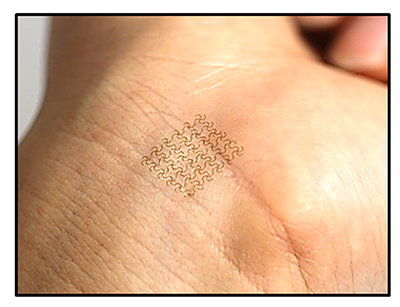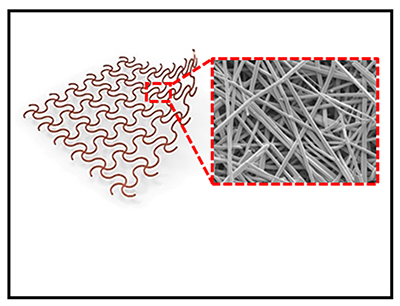The electronic band-aid’s biomedical engineering new development done by United States researchers offers therapeutic stimulation to all of its users. This ‘bandage’ is a breakthrough in biomedical technology which has the skin’s elasticity in addition to its sensory functions. The tech uses conducting nanowires that run around the entire system to provide therapeutic sensations. Source: Purdue University (Electronic Band-Aid Is The Next Big Thing In Biomedical Engineering)These small but efficient nanowires are covered with elastic polymer that’s laid out really thin. This property of the tech is what makes people call it an electronic bandage. A collaborative effort of scientists and researchers all over the US made the development of this bandage possible.Chi Hwan Lee, assistant professor of Biomedical Engineering and Mechanical Engineering at Purdue University, assessed the technology could adhere to human skin and at the same time create a biofeedback like electrophysiological signals. He also added that the nanomaterials they used for this pseudo-skin technology is of high quality, furthering its mechanical capabilities.The engineering professor also admits that the bandage isn’t just what the team is creating. The elasticity and mesh film that this new biomedical technology provides make it stand above the rest. Lee explained that the mesh film has an astounding surface area coverage as compared to the regular films. In numbers, it’s 1,000 times greater surface roughness than that of the conventional technology.
Source: Purdue University (Electronic Band-Aid Is The Next Big Thing In Biomedical Engineering)These small but efficient nanowires are covered with elastic polymer that’s laid out really thin. This property of the tech is what makes people call it an electronic bandage. A collaborative effort of scientists and researchers all over the US made the development of this bandage possible.Chi Hwan Lee, assistant professor of Biomedical Engineering and Mechanical Engineering at Purdue University, assessed the technology could adhere to human skin and at the same time create a biofeedback like electrophysiological signals. He also added that the nanomaterials they used for this pseudo-skin technology is of high quality, furthering its mechanical capabilities.The engineering professor also admits that the bandage isn’t just what the team is creating. The elasticity and mesh film that this new biomedical technology provides make it stand above the rest. Lee explained that the mesh film has an astounding surface area coverage as compared to the regular films. In numbers, it’s 1,000 times greater surface roughness than that of the conventional technology. Source: Purdue University (Electronic Band-Aid Is The Next Big Thing In Biomedical Engineering)In common terms, this large area is what’s responsible for the film’s adhesion to the skin. For the users, this means lesser risks of the bandage accidentally being removed from the point of contact. This is absolutely necessary for technology like this as it is required to do way more than the average bandage.The signals sent out by the bandage can be recorded for a multitude of uses. For example, a doctor can get accurate readings of the user’s vital signs, including heart rate and muscle activity. Unlike regular devices that monitor these, the electronic bandage does not present any bulkiness or restriction. It also removes the need for internal surgery to place in cardiology trackers. This is good news for end-users as scarring can now be avoided due to this new tech.https://www.youtube.com/embed/tYRebHNi6p4Source: YouTube, Purdue Engineering (Electronic Band-Aid Is The Next Big Thing In Biomedical Engineering)Each nanowire is 50 nanometers in diameter and measures 150 microns in length. These wires are then sandwiched inside 1.5 microns of thin elastic polymer. Lee mentioned that this process of manufacturing the tech was derived from many conventional techniques.“The nanowires mesh film was initially formed on a conventional silicon wafer with existing micro- and nano-fabrication technologies,” said Lee. Their approach, called the “crack-driven transfer printing technique”, makes it possible for them to peel the device layer away from the silicon wafer, and then replacing it on skin.The possibilities of the technology are endless. The team strives to forward the research into the field of transdermal drug delivery. The nano-fabricated bandages could transport medicine into the skin electronically. More so, it could create a scheduling system so medicine can be dispensed at specific timeframes or possibly dispense it only when the wearer needs it. This could control the use of pain relievers or offer a foolproof way to schedule medications, both leading to a success in the medical field.If this technology reaches completion, we can see a bright future for biomedical engineering. This new revolutionary tech can be a cornerstone to better skin-related technology in the near future. Oklahoma State University aided in the theoretical simulations of the device’s workings. Their research is available for public viewing at the Wiley Online Library. In-depth details are also found at the Purdue University website.
Source: Purdue University (Electronic Band-Aid Is The Next Big Thing In Biomedical Engineering)In common terms, this large area is what’s responsible for the film’s adhesion to the skin. For the users, this means lesser risks of the bandage accidentally being removed from the point of contact. This is absolutely necessary for technology like this as it is required to do way more than the average bandage.The signals sent out by the bandage can be recorded for a multitude of uses. For example, a doctor can get accurate readings of the user’s vital signs, including heart rate and muscle activity. Unlike regular devices that monitor these, the electronic bandage does not present any bulkiness or restriction. It also removes the need for internal surgery to place in cardiology trackers. This is good news for end-users as scarring can now be avoided due to this new tech.https://www.youtube.com/embed/tYRebHNi6p4Source: YouTube, Purdue Engineering (Electronic Band-Aid Is The Next Big Thing In Biomedical Engineering)Each nanowire is 50 nanometers in diameter and measures 150 microns in length. These wires are then sandwiched inside 1.5 microns of thin elastic polymer. Lee mentioned that this process of manufacturing the tech was derived from many conventional techniques.“The nanowires mesh film was initially formed on a conventional silicon wafer with existing micro- and nano-fabrication technologies,” said Lee. Their approach, called the “crack-driven transfer printing technique”, makes it possible for them to peel the device layer away from the silicon wafer, and then replacing it on skin.The possibilities of the technology are endless. The team strives to forward the research into the field of transdermal drug delivery. The nano-fabricated bandages could transport medicine into the skin electronically. More so, it could create a scheduling system so medicine can be dispensed at specific timeframes or possibly dispense it only when the wearer needs it. This could control the use of pain relievers or offer a foolproof way to schedule medications, both leading to a success in the medical field.If this technology reaches completion, we can see a bright future for biomedical engineering. This new revolutionary tech can be a cornerstone to better skin-related technology in the near future. Oklahoma State University aided in the theoretical simulations of the device’s workings. Their research is available for public viewing at the Wiley Online Library. In-depth details are also found at the Purdue University website.
Electronic Band-Aid Is The Next Big Thing In Biomedical Engineering










